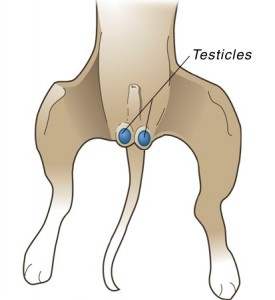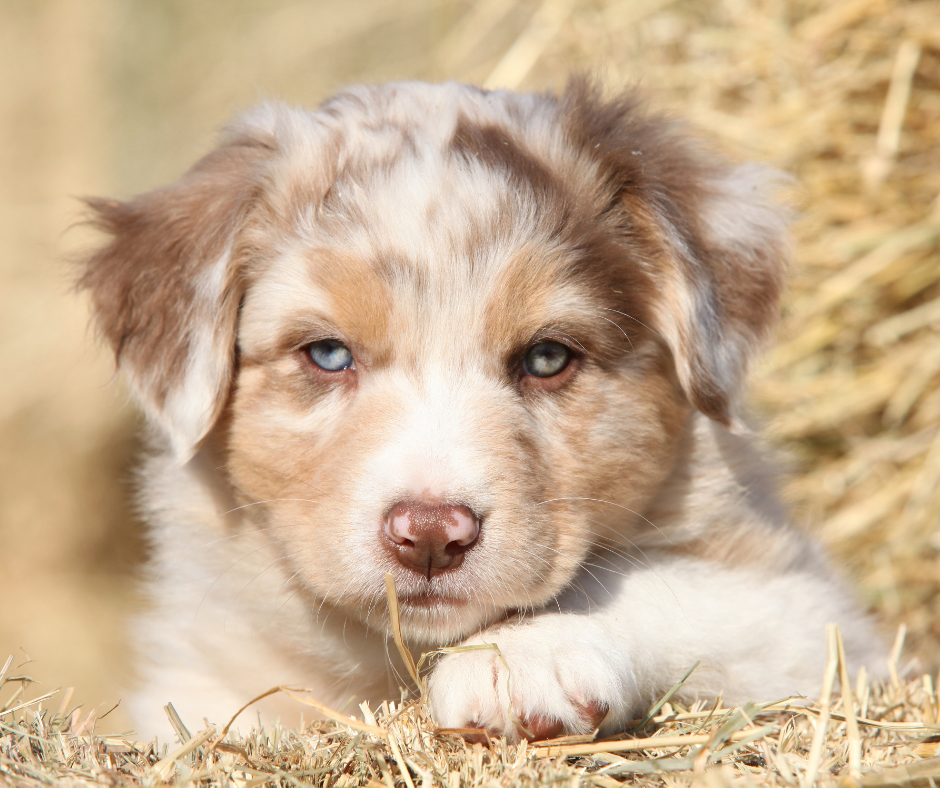The Patient
Astro, a 2-month-old, intact, male Australian Shepherd puppy, came to see me for his first check-up. His owner had just purchased him from a breeder a few days before. He was happy, peppy, and full of energy.
The Case
On physical examination, I was only able to palpate one testicle in the scrotum where there should always be two. Even though he was a wiggly guy, I felt confident that he had a retained testicle. I recommended that we check him over again at his next doctor's exam at 4 months of age to be sure. He received his first set of puppy vaccinations, deworming, and client education materials - as we always do during a new puppy visit. During his 16 week final puppy exam, I was still only palpating one testicle in the scrotum. Astro was diagnosed as being unilaterally cryptorchid. All male dogs have two testicles. When a male puppy is developing, both testicles are actually located up in the abdomen similar to the ovaries of a female dog. As the puppy matures, the testicles then travel along a path into the scrotal sac located outside the body wall. This is because the testicles require a lower temperature to produce sperm and remain healthy than the rest of the organs in the abdomen. Their location in the scrotum provides a cooler temperature and also makes the surgical procedure of castration (neutering) much easier and less invasive. They typically arrive in the scrotum by 8 weeks of age, although sometimes it takes a bit longer. When a testicle is retained, it can be located anywhere along the path of migration, either up in the abdomen, in the inguinal ring, or in the subcutaneous tissue of the groin. If it is in the groin area, I can sometimes palpate it under the skin, just in the wrong location. The inguinal ring is the small opening between the abdomen and the groin or upper inner thigh where all the major blood vessels exit the abdomen to enter the leg. I discussed with Astro's owner that the neuter would be a little more challenging as we go on a hunt to find the missing testicle. There are many benefits to neutering dogs if they are not intended for breeding. We can completely eliminate the risk of testicular cancer, testicular torsion (flipping over of the testicle on its blood supply), certain prostate diseases such as benign prostatic hyperplasia (a disease very common in humans), and certain types of anal cancer. In dogs that are cryptorchid, the risk of testicular cancer and torsion is actually much higher due to the location of the testicle in the higher temperature of the belly. In addition, neutered dogs are less likely to escape their yard in search of intact females; intact males are at higher risk of being hit by a car.

The Treatment Plan
I strongly recommended neutering Astro when he was about 6 months of age. We typically wait until about 6 months of age prior to the neuter as it allows time for all the baby teeth to fall out so we can be sure there are no retained baby teeth and to make the anesthesia a bit safer. Astro's owner agreed.
The Outcome
A few months later, Astro arrived for his surgical procedure. I induced general anesthesia and began to prepare him for his castration. When he was sleeping and rolled onto his back, I deeply palpated his groin to see if I could find the missing testicle and lo and behold, I found it buried in the subcutaneous fat of the groin. Hooray! I did need to make two incisions--one at the typical site just in front of the scrotum and the other just off to the side at the site of the second testicle. Thankfully, his neuter was pretty straightforward. It is more common that the testicle is up in the abdomen and so these dogs typically require a full ventral midline incision into the abdomen just like a female dog would have for a spay. Astro recovered beautifully and was discharged with pain control and a sedative to keep his silly self calm during the surgical recovery period of 10 days. Very rarely, a male dog can have two retained testicles, also known as bilaterally cryptorchid, which means there are two testicles to find during the surgery. I do see dogs with retained testicles fairly routinely but it is very rare in cats. If you have questions about neutering your dog, please call us at 760-753-9393.

The Drake Center for Veterinary Care is an AAHA-accredited animal hospital located in Encinitas, CA. The Drake Center loves being a source of information for all pet owners across the country however if you have any questions regarding pet care and do not live in Encinitas, CA or surrounding cities, we encourage you to contact your local veterinarian.

